1. Task experiment 1
- Task 1-1
- task1_1.asm source code:
1 assume ds:data, cs:code, ss:stack 2 3 data segment 4 db 16 dup(0) 5 data ends 6 7 stack segment 8 db 16 dup(0) 9 stack ends 10 11 code segment 12 start: 13 mov ax, data 14 mov ds, ax 15 16 mov ax, stack 17 mov ss, ax 18 mov sp, 16 19 20 mov ah, 4ch 21 int 21h 22 code ends 23 end
-
- Screenshot:
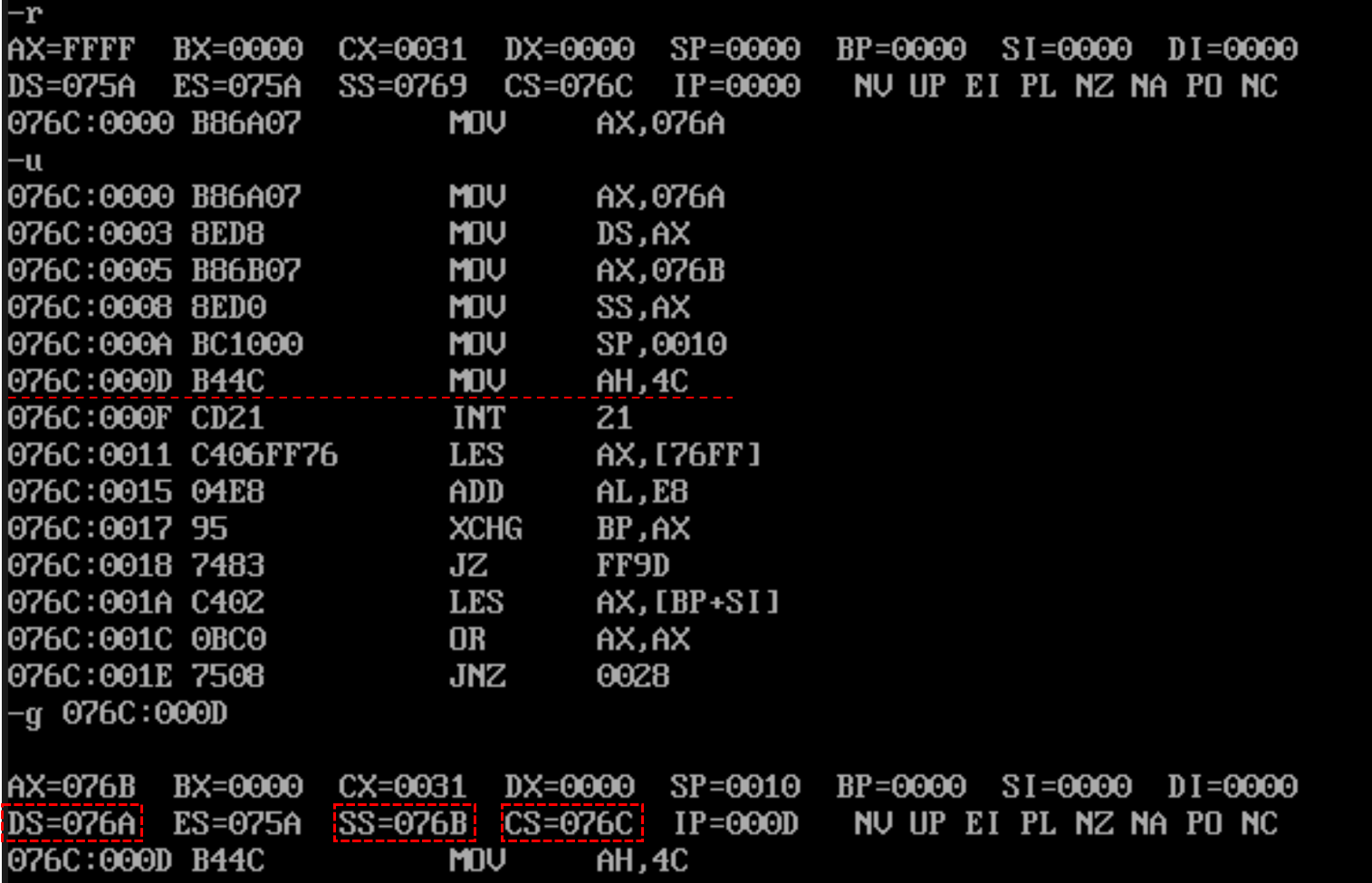
-
- Question answer:
(1) In debug, record the end of line17 and before line19: register (DS)=076A, register (SS)=076B and register (CS)=076C.
(2) assuming that the segment address of code is X after the program is loaded, the segment address of data segment is X-2 and the segment address of stack is X-1.
- Task 1-2
- task1_2.asm source code:
1 assume ds:data, cs:code, ss:stack 2 3 data segment 4 db 4 dup(0) 5 data ends 6 7 stack segment 8 db 8 dup(0) 9 stack ends 10 11 code segment 12 start: 13 mov ax, data 14 mov ds, ax 15 16 mov ax, stack 17 mov ss, ax 18 mov sp, 8 19 20 mov ah, 4ch 21 int 21h 22 code ends 23 end
-
- Screenshot:
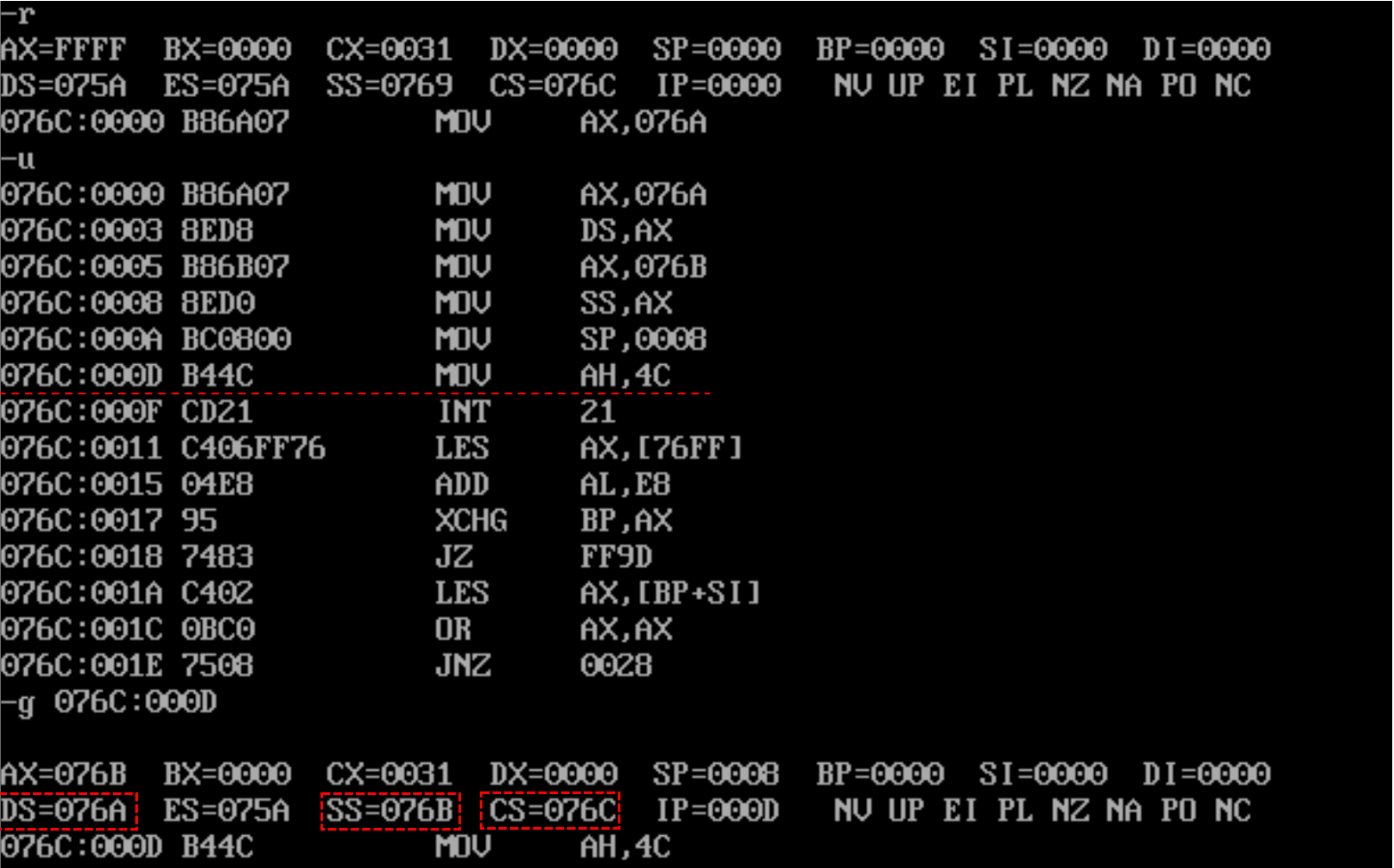
-
- Question answer:
(1) In debug, record the end of line17 and before line19: register (DS)=076A, register (SS)=076B and register (CS)=076C.
(2) Assuming that the segment address of code is X after the program is loaded, the segment address of data segment is X-2 and the segment address of stack is X-1.
- Task 1-3
- task1_3.asm source code:
1 assume ds:data, cs:code, ss:stack 2 3 data segment 4 db 20 dup(0) 5 data ends 6 7 stack segment 8 db 20 dup(0) 9 stack ends 10 11 code segment 12 start: 13 mov ax, data 14 mov ds, ax 15 16 mov ax, stack 17 mov ss, ax 18 mov sp, 20 19 20 mov ah, 4ch 21 int 21h 22 code ends 23 end
-
- Screenshot:
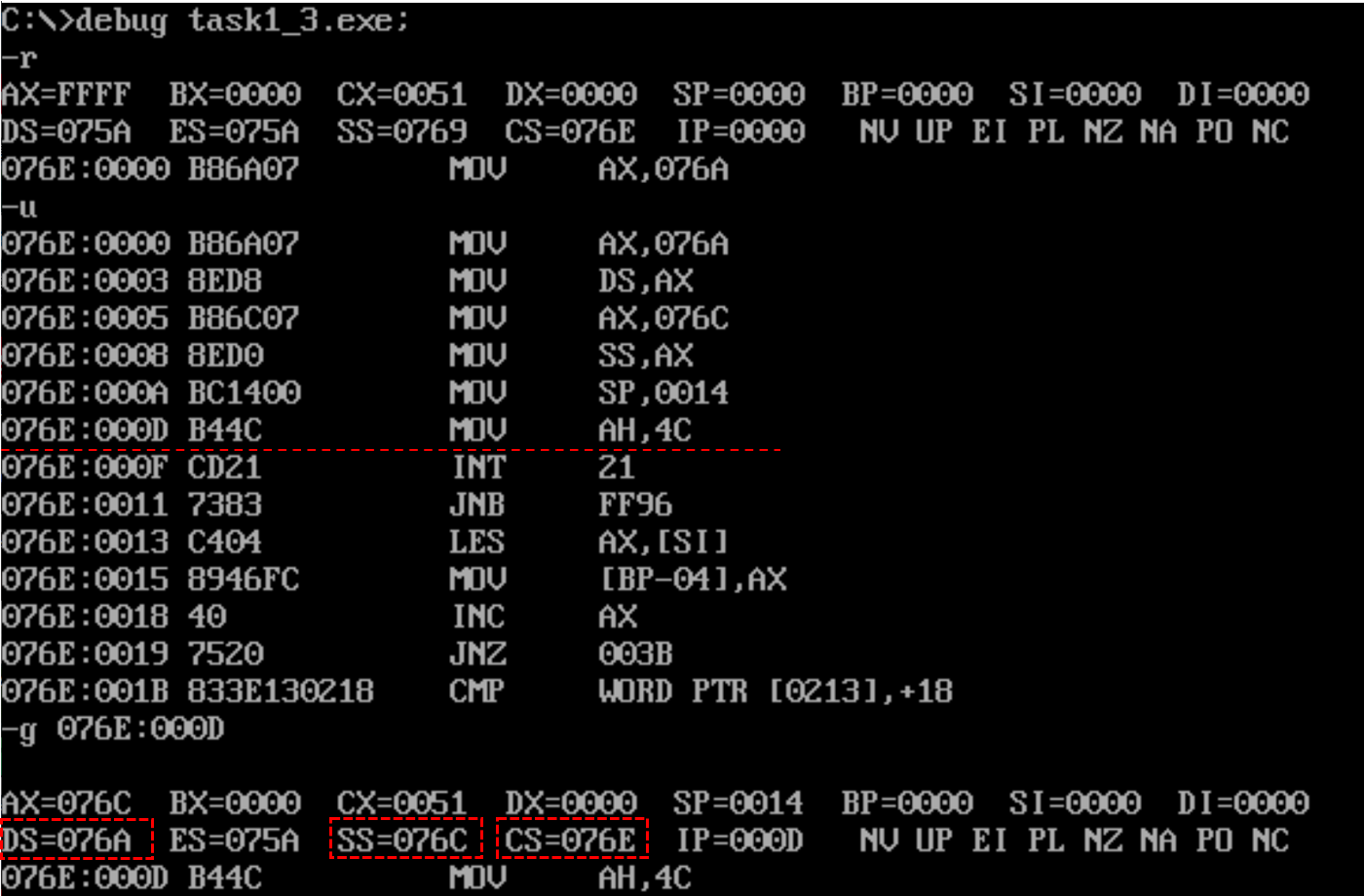
-
- Question answer:
(1) In the debug process, before the end of line17 and line19, register (DS)=076A, register (SS)=076C and register (CS)=076E.
(2) assuming that the segment address of code is X after the program is loaded, the segment address of data segment is X-4 and the segment address of stack is X-2.
- Tasks 1-4
- task1_4.asm source code:
1 assume ds:data, cs:code, ss:stack 2 code segment 3 start: 4 mov ax, data 5 mov ds, ax 6 7 mov ax, stack 8 mov ss, ax 9 mov sp, 20 10 11 mov ah, 4ch 12 int 21h 13 code ends 14 15 data segment 16 db 20 dup(0) 17 data ends 18 19 stack segment 20 db 20 dup(0) 21 stack ends 22 end
-
- Screenshot:
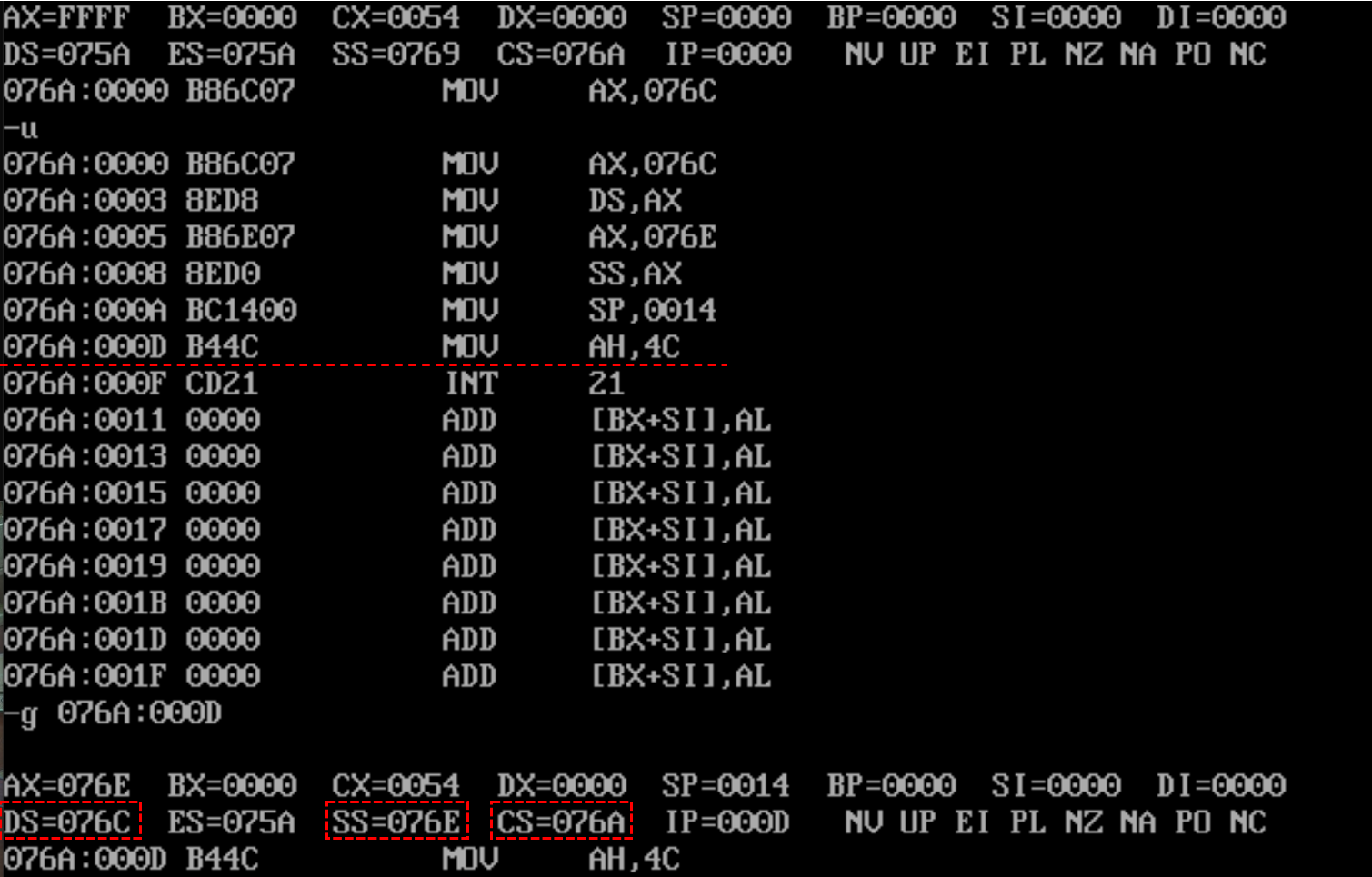
-
- Question answer:
(1) In the debug process, before the end of line17 and line19, register (DS)=076C, register (SS)=076E and register (CS)=076A.
(2) Assuming that after the program is loaded, the segment address of code is X, the segment address of data segment is X+2, and the segment address of stack is X+4.
- Tasks 1-5
- Based on the practice, observation, summary and answer of the above four experimental tasks:
(1) for the segment defined below, after the program is loaded, the actual content space allocated to the segment is [N/16]*16 (rounded up).
1 xxx segment 2 db N dup(0) 3 xxx ends
(2) If the program task1_1.asm,task1_2.asm,task1_3.asm,task1_ 4. In ASM, if the pseudo instruction end start is changed to end, which program can still be executed correctly. Combined with the conclusions obtained from practical observation, analyze and explain the reasons.
A: only task1_4.asm can be executed. Replacing end start with end means that the program does not specify the start position, and the whole code segment (including the data segment) is executed as execution code, so the data in the execution data segment will naturally make an error.
2. Task experiment 2
- task2.asm assembly source code:
1 assume cs:code 2 code segment 3 start: 4 mov ax,0b800h 5 mov ds,ax 6 mov bx,0f00h 7 mov cx,80 8 p: mov ds:[bx],0403h 9 inc bx 10 inc bx 11 loop p 12 13 mov ah,4ch 14 int 21h 15 code ends 16 end start
- Screenshot:

3. Task experiment 3
- task3.asm assembly source code:
1 assume cs:code 2 data1 segment 3 db 50, 48, 50, 50, 0, 48, 49, 0, 48, 49 ; ten numbers 4 data1 ends 5 6 data2 segment 7 db 0, 0, 0, 0, 47, 0, 0, 47, 0, 0 ; ten numbers 8 data2 ends 9 10 data3 segment 11 db 16 dup(0) 12 data3 ends 13 14 code segment 15 start: 16 mov ax,data1 17 mov ds,ax 18 mov cx,16 19 mov bx,0 20 s: mov al,ds:[bx] 21 add al,ds:[bx+16] 22 mov ds:[bx+32],al 23 inc bx 24 loop s 25 26 mov ah,4ch 27 int 21h 28 code ends 29 end start
- Screenshot:
- Front screenshot of data enhancement in turn:
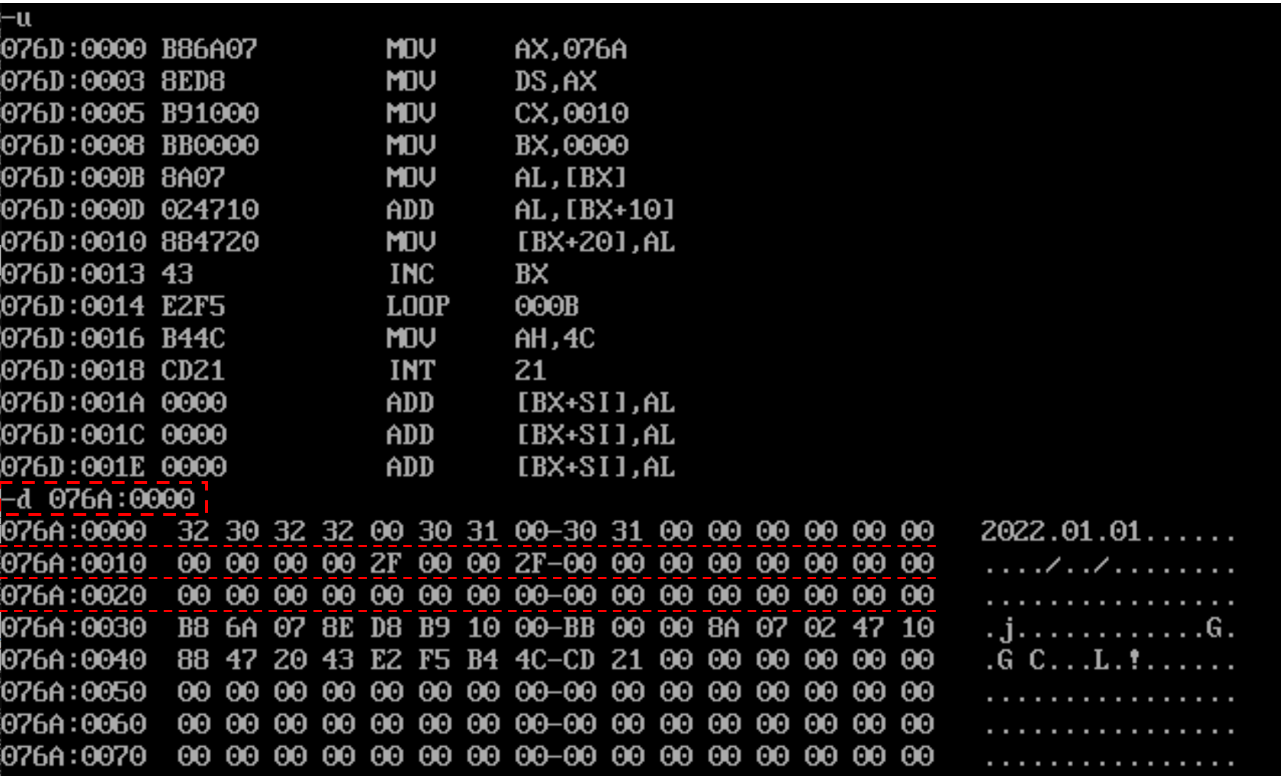
-
- Screenshot after adding data in sequence:

4. Task experiment 4
- task4.asm assembly source code:
1 assume cs:code 2 3 data1 segment 4 dw 2, 0, 4, 9, 2, 0, 1, 9 5 data1 ends 6 7 data2 segment 8 dw 8 dup(?) 9 data2 ends 10 stack segment 11 db 16 dup(0) 12 stack ends 13 code segment 14 start: 15 mov ax,data1 16 mov ds,ax 17 mov ax,stack 18 mov ss,ax 19 mov sp,16 20 mov bx,0 21 mov cx,8 22 s1: 23 push ds:[bx] 24 inc bx 25 inc bx 26 loop s1 27 28 mov bx,16 29 mov cx,8 30 s2: 31 pop ds:[bx] 32 inc bx 33 inc bx 34 loop s2 35 36 mov ah, 4ch 37 int 21h 38 code ends 39 end start
- Screenshot:
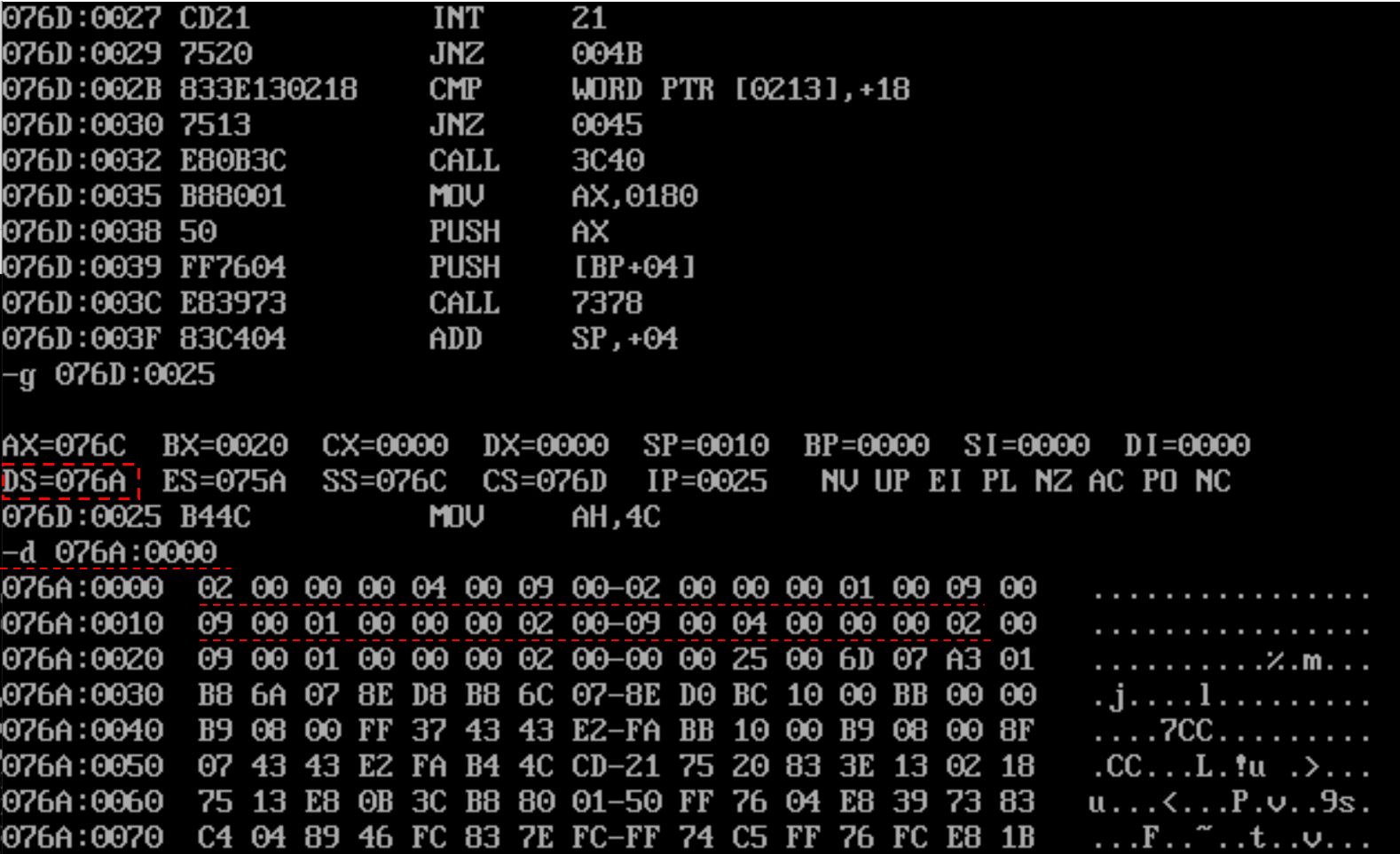
5. Task experiment 5
- task5.asm assembly source code:
1 assume cs:code, ds:data 2 data segment 3 db 'Nuist' 4 db 5 dup(2) 5 data ends 6 7 code segment 8 start: 9 mov ax, data 10 mov ds, ax 11 12 mov ax, 0b800H 13 mov es, ax 14 15 mov cx, 5 16 mov si, 0 17 mov di, 0f00h 18 s: mov al, [si] 19 and al, 0dfh 20 mov es:[di], al 21 mov al, [5+si] 22 mov es:[di+1], al 23 inc si 24 add di, 2 25 loop s 26 27 mov ah, 4ch 28 int 21h 29 code ends 30 end start
- Screenshot of operation results:

- Screenshot after line25 and before line27:

- Function of line19 in source code:
A: convert all lowercase letters to uppercase letters.
- Purpose of byte data in data segment line4 in source code:
A: set the font color.
6. Task experiment 6
- task6.asm assembly source code:
1 assume cs:code, ds:data 2 3 data segment 4 db 'Pink Floyd ' 5 db 'JOAN Baez ' 6 db 'NEIL Young ' 7 db 'Joan Lennon ' 8 data ends 9 10 code segment 11 start: 12 mov ax,data 13 mov ds,ax 14 mov cx,4 15 mov bx,0 16 s: 17 mov dx,cx 18 mov cx,4 19 mov si,0 20 p: 21 mov al,ds:[bx+si] 22 or al,00100000B 23 mov ds:[bx+si],al 24 inc si 25 loop p 26 27 add bx,16 28 mov cx,dx 29 loop s 30 31 mov ah, 4ch 32 int 21h 33 code ends 34 end start
- Screenshot:
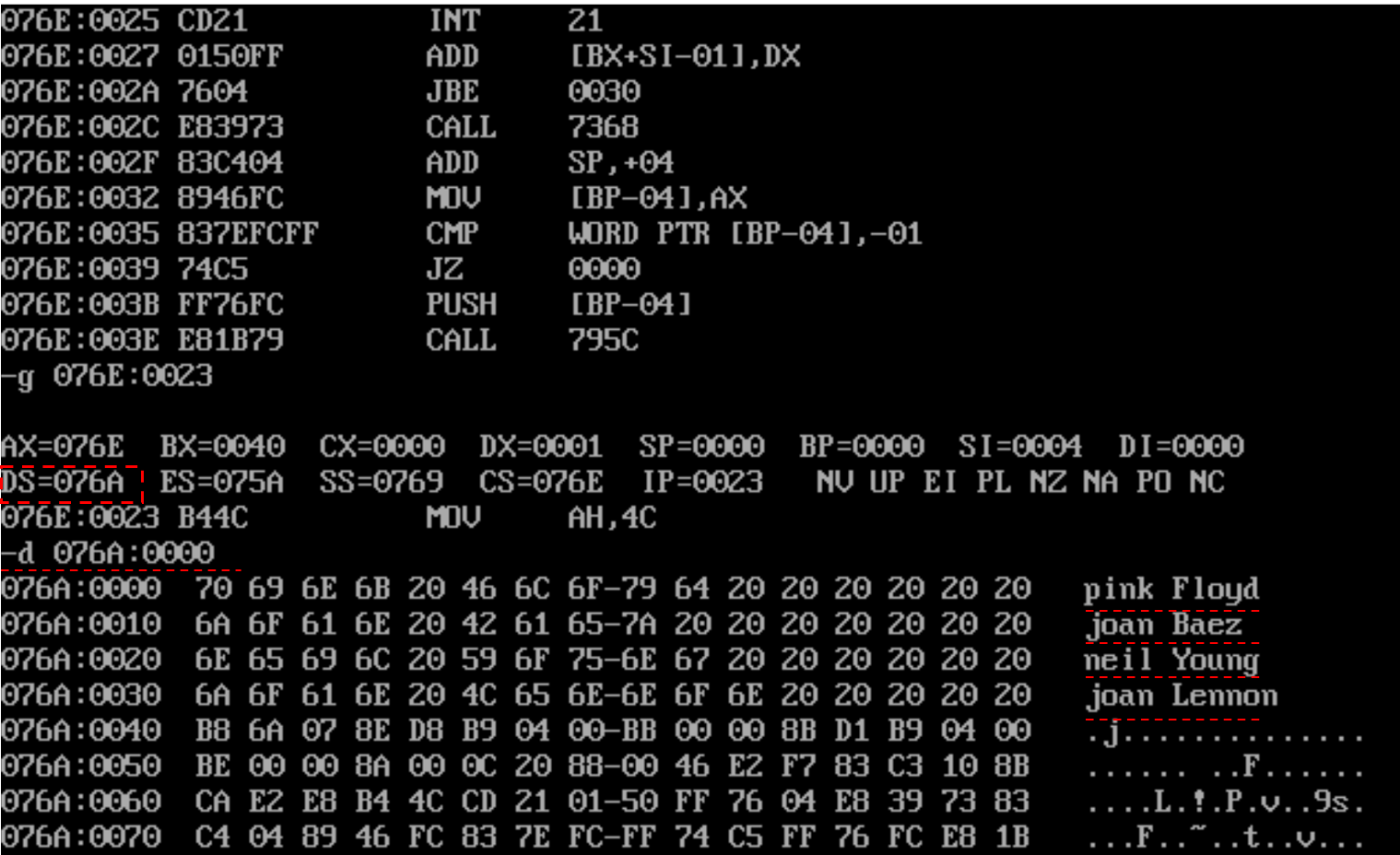
7. Task experiment 7
- task7.asm assembly source code:
1 assume cs:code, ds:data, es:table 2 3 data segment 4 db '1975', '1976', '1977', '1978', '1979' 5 dw 16, 22, 382, 1356, 2390 6 dw 3, 7, 9, 13, 28 7 data ends 8 9 table segment 10 db 5 dup( 16 dup(' ') ) ; 11 table ends 12 13 code segment 14 start: 15 mov ax,data 16 mov ds,ax 17 mov ax,table 18 mov es,ax 19 mov si,0 20 mov di,0 21 mov bx,0 22 mov cx,5 23 mov sp,0 24 25 s: mov ax,[si] 26 mov es:[di],ax 27 mov ax,[si+2] 28 mov es:[di+2],ax 29 mov ax,[bx+20] 30 mov es:[di+5],ax 31 mov dx,0 32 mov es:[di+7],dx 33 push cx 34 mov cx,[20+10+bx] 35 mov es:[di+10],cx 36 div cx 37 pop cx 38 mov es:[di+0dh],ax 39 add si,4 40 add di,16 41 add bx,2 42 loop s 43 44 mov ah, 4ch 45 int 21h 46 code ends 47 end start
- Screenshot:
- Screenshot of original data information of table segment:
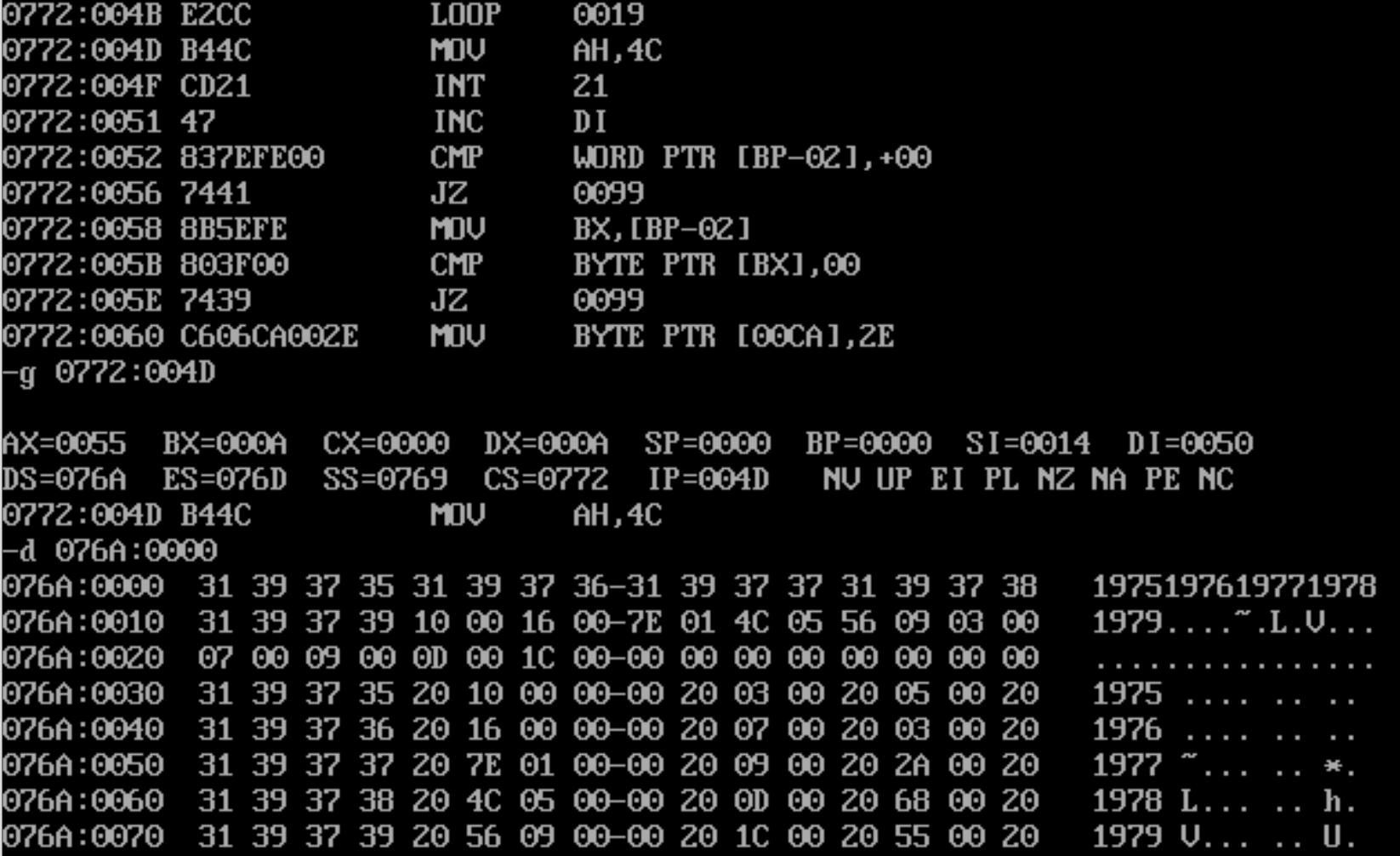
-
- Screenshot of the memory space corresponding to the table segment before the program exits:
